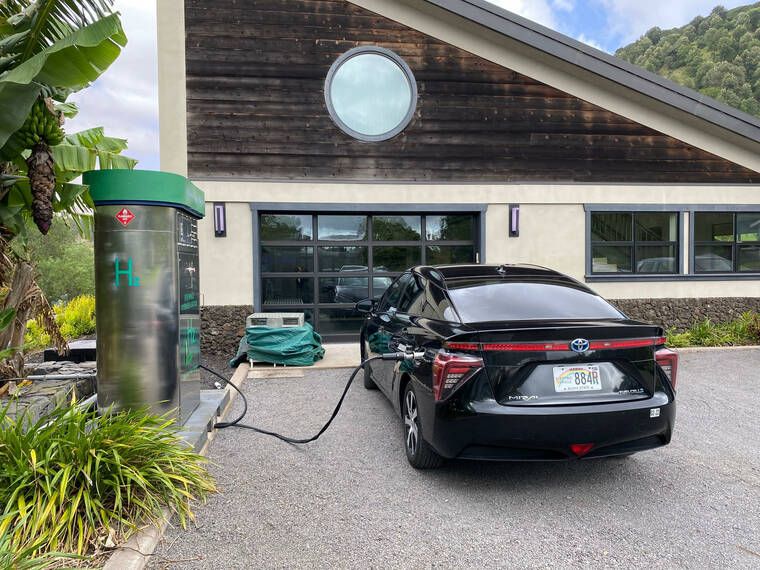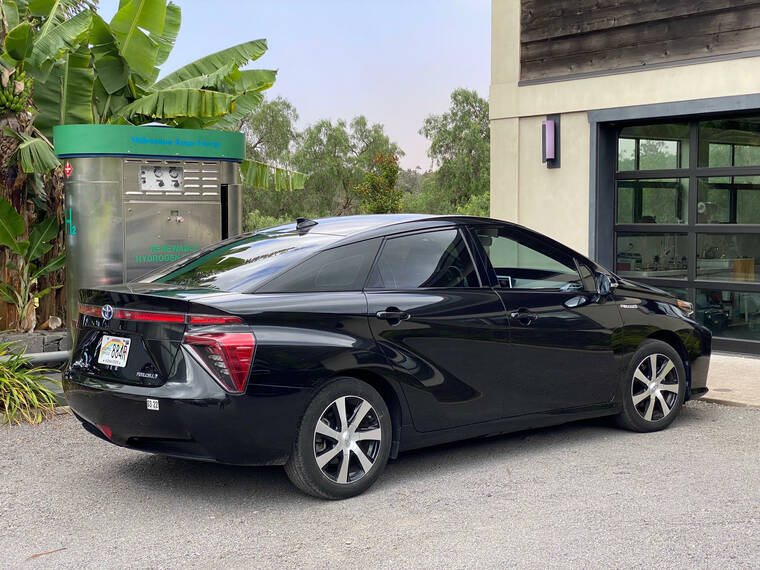The first hydrogen fuel cell electric vehicle has landed on the Big Island, and officials hope many more will follow.
The 2017 Toyota Mirai arrived recently at the Puu Waawaa energy ranch, an off-grid laboratory devoted to testing and developing renewable energy systems. The first hydrogen vehicles in the county government’s Hele-On bus fleet, meanwhile, are a little behind schedule.
“Mirai means future endeavors,” said Paul Ponthieux, director and chief technology officer of Blue Planet Research. “The hydrogen we make from our excess solar power is what’s fueling this car right now. You can’t get any greener than this.”
Ponthieux said the car, which was privately purchased and delivered by sustainable energy developer H2 Energy, will be used to promote hydrogen infrastructure on the island at demonstrations and events. He said a wrap is being designed to explain that the car is hydrogen-powered, essentially running on water.
The county’s own hydrogen fuel vehicle efforts, however, have been lagging. A fueling station, using hydrogen fuel produced at the Natural Energy Laboratory of Hawaii Authority, has been installed in Kailua-Kona.
Funding for the necessary equipment was provided by grants awarded more than five years ago from the U.S. Department of Energy, the Office of Naval Research and the state’s hydrogen fund.
The buses themselves, however, are behind schedule.
The first bus is a 2014 Eldorado 29-passenger Aero Elite vehicle that was donated to the county by the University of Hawaii Natural Energy Institute after it was converted from diesel power and upgraded to fuel cells that run on hydrogen fuel. It’s currently in Honolulu, where a fuel cell issue is being addressed, said interim Transit Administrator John Andoh.
“They’re getting close,” Andoh said Friday.
Two other buses, shuttle buses donated by Hawaii Volcanoes National Park, are awaiting parts after supply chain disruptions caused by the coronavirus pandemic, he said.
Andoh is also working on bidding documents to purchase more zero-emission vehicles using money from the Hawaii Department of Transportation.
“We’re all headed in the same direction,” said Riley Saito, energy specialist at the county Department of Research and Development.
Saito said the county is working closely with innovators such as Blue Planet and NELHA. He and Ponthieux likened the emergence of the new fuel source to a chicken and egg problem. The vehicles need hydrogen fueling stations, while the fueling stations can’t be economically constructed without an assured customer base.
“Everybody says of hydrogen it doesn’t progress because of the chicken and egg problem,” Saito said. “Well, the fueling stations are the chickens, the buses are the eggs and the county is the hen-house.”
Eventually, Ponthieux said, there will be at least five or six hydrogen “filling stations” on the island, where a car can be charged in as little as five minutes, compared to the eight hours it takes to recharge a conventional battery-powered electric vehicle.
“There’s no silver bullet,” he said about choices between the two technologies. “There’s silver buckshot and this is one of the pieces of the buckshot.”
Most condo buildings don’t have the infrastructure to run too many charging stations, he said. The limited number of stations would have to be first-come, first-serve. Condo owners aren’t going to want to leave their cars charging overnight in the Target parking lot, he said.
Ponthieux sees the possibility of taking three-year-old lease car turn-ins and fitting them with hydrogen cells, then selling them with fuel built into the price, enabling early adopters to have fuel paid upfront and ensuring the fueling station infrastructure can be built.


